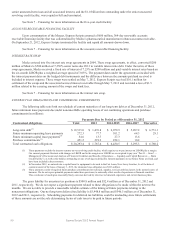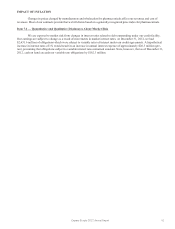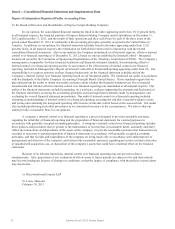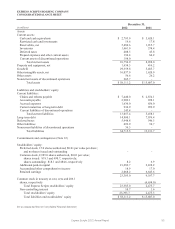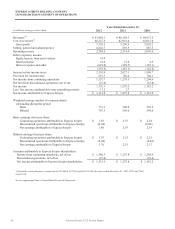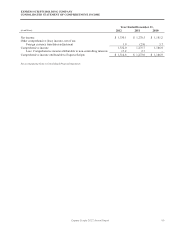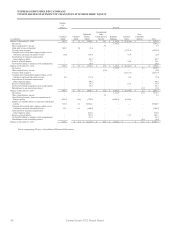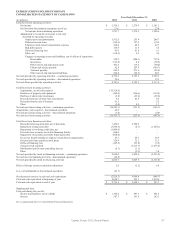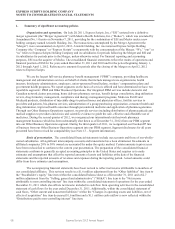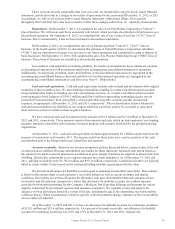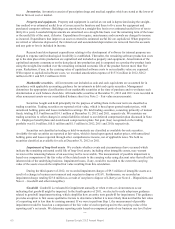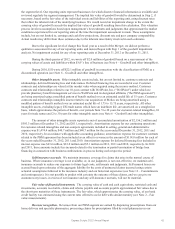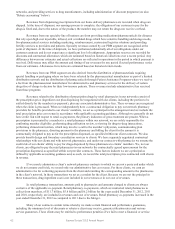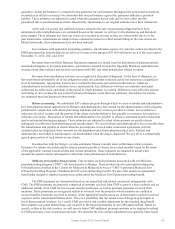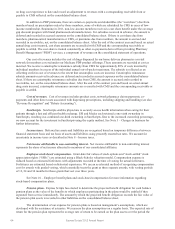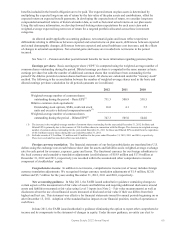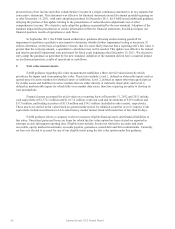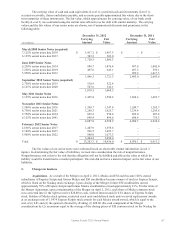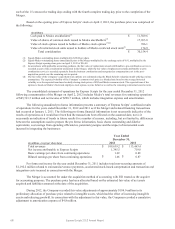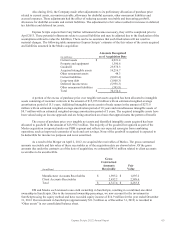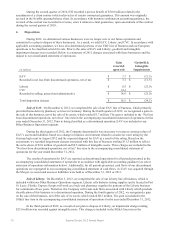Express Scripts 2012 Annual Report Download - page 62
Download and view the complete annual report
Please find page 62 of the 2012 Express Scripts annual report below. You can navigate through the pages in the report by either clicking on the pages listed below, or by using the keyword search tool below to find specific information within the annual report.Express Scripts 2012 Annual Report60
59
Inventories. Inventories consist of prescription drugs and medical supplies which are stated at the lower of
first-in first-out cost or market.
Property and equipment. Property and equipment is carried at cost and is depreciated using the straight-
line method over estimated useful lives of seven years for furniture and three to five years for equipment and
purchased computer software. Buildings are amortized on a straight-line basis over estimated useful lives of ten to
thirty-five years. Leasehold improvements are amortized on a straight-line basis over the remaining term of the lease
or the useful life of the asset, if shorter. Expenditures for repairs, maintenance and renewals are charged to income
as incurred. Expenditures that improve an asset or extend its estimated useful life are capitalized. When properties
are retired or otherwise disposed of, the related cost and accumulated depreciation are removed from the accounts
and any gain or loss is included in income.
Research and development expenditures relating to the development of software for internal purposes are
charged to expense until technological feasibility is established. Thereafter, the remaining software production costs
up to the date placed into production are capitalized and included as property and equipment. Amortization of the
capitalized amounts commences on the date placed into production and is computed on a product-by-product basis
using the straight-line method over the remaining estimated economic life of the product but not more than five
years. Reductions, if any, in the carrying value of capitalized software costs to net realizable value are expensed.
With respect to capitalized software costs, we recorded amortization expense of $137.6 million in 2012, $26.2
million in 2011 and $23.2 million in 2010.
Marketable securities. All investments not included as cash and cash equivalents are accounted for in
accordance with applicable accounting guidance for investments in debt and equity securities. Management
determines the appropriate classification of our marketable securities at the time of purchase and re-evaluates such
determination at each balance sheet date. All marketable securities at December 31, 2012 and 2011 were recorded in
other noncurrent assets on our consolidated balance sheet (see Note 2 – Fair value measurements).
Securities bought and held principally for the purpose of selling them in the near term are classified as
trading securities. Trading securities are reported at fair value, which is based upon quoted market prices, with
unrealized holding gains and losses included in earnings. We held trading securities, consisting primarily of mutual
funds, totaling $15.8 million and $14.1 million at December 31, 2012 and 2011, respectively. We maintain our
trading securities to offset changes in certain liabilities related to our deferred compensation plan discussed in Note
10 – Employee benefit plans and stock-based compensation plans. Net gain (loss) recognized on the trading
portfolio was $1.0 million, $(0.1) million and $1.5 million in 2012, 2011 and 2010, respectively.
Securities not classified as trading or held-to-maturity are classified as available-for-sale securities.
Available-for-sale securities are reported at fair value, which is based upon quoted market prices, with unrealized
holding gains and losses reported through other comprehensive income, net of applicable taxes. We held no
securities classified as available for sale at December 31, 2012 or 2011.
Impairment of long-lived assets. We evaluate whether events and circumstances have occurred which
indicate the remaining estimated useful life of long-lived assets, including other intangible assets, may warrant
revision or the remaining balance of an asset may not be recoverable. The measurement of possible impairment is
based on a comparison of the fair value of the related assets to the carrying value using discount rates that reflect the
inherent risk of the underlying business. Impairment losses, if any, would be recorded to the extent the carrying
value of the assets exceeds the implied fair value resulting from this calculation.
During the third quarter of 2012, we recorded impairment charges of $9.5 million of intangible assets as a
result of a change in business environment and our plan to dispose of EAV. Furthermore, we recorded an
impairment charge totaling $23.0 million as a result of our plan to dispose of Liberty (see Note 4 – Dispositions and
Note 6 – Goodwill and other intangibles).
Goodwill. Goodwill is evaluated for impairment annually or when events or circumstances occur
indicating that goodwill might be impaired. In the fourth quarter of 2011, we elected to early adopt new guidance
related to goodwill impairment testing, which simplifies how an entity tests goodwill for impairment. This guidance
provides an option to first assess qualitative factors to determine whether it is more likely than not that the fair value
of a reporting unit is less than its carrying amount. If we were to perform Step 1, the measurement of possible
impairment would be based on a comparison of the fair value of each reporting unit to the carrying value of the
reporting unit’s net assets. We determine reporting units based on component parts of our business one level below


